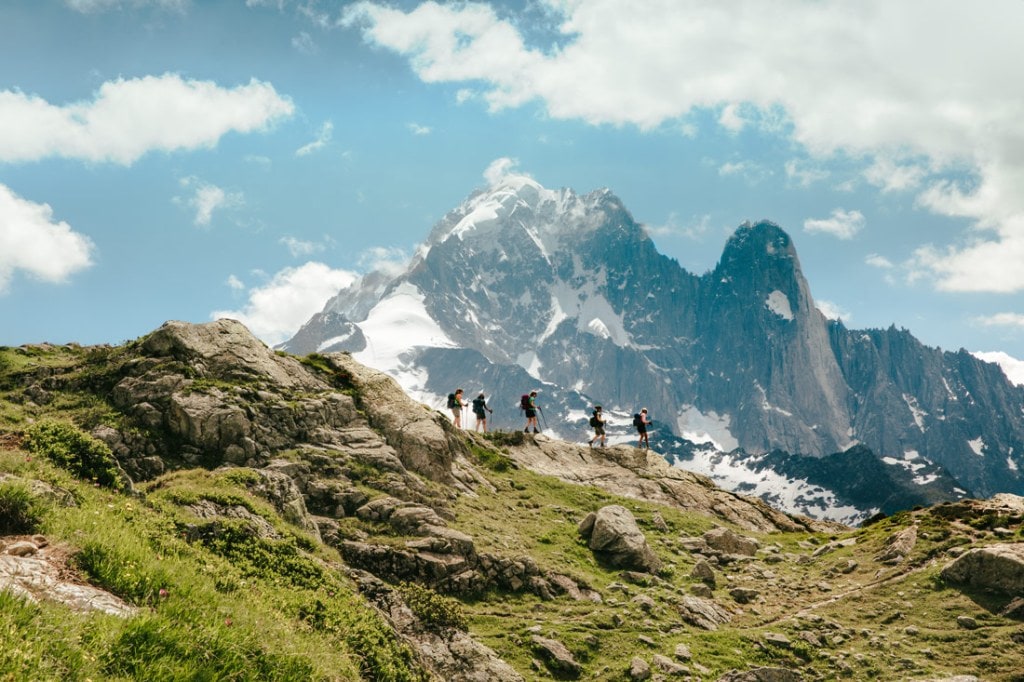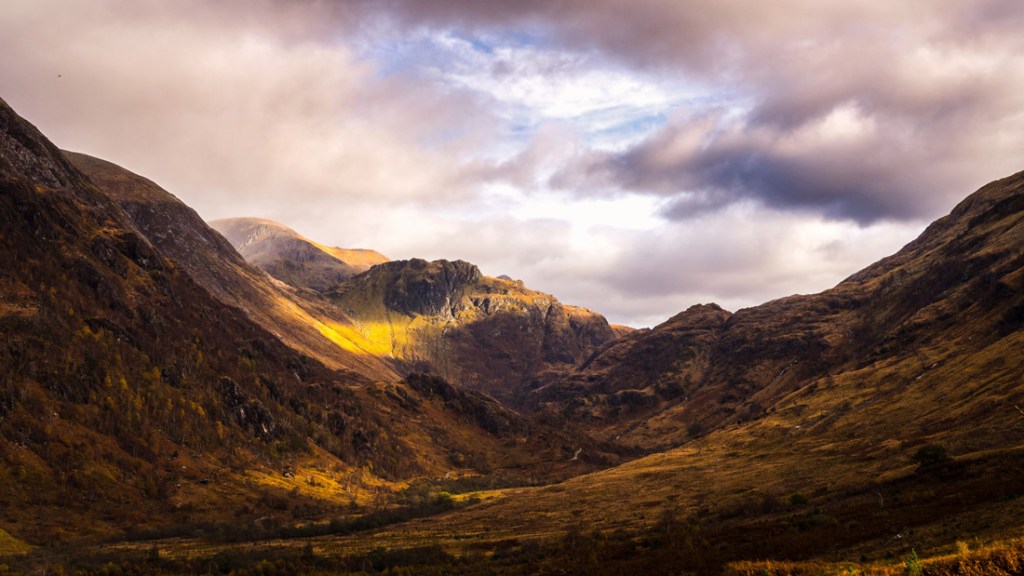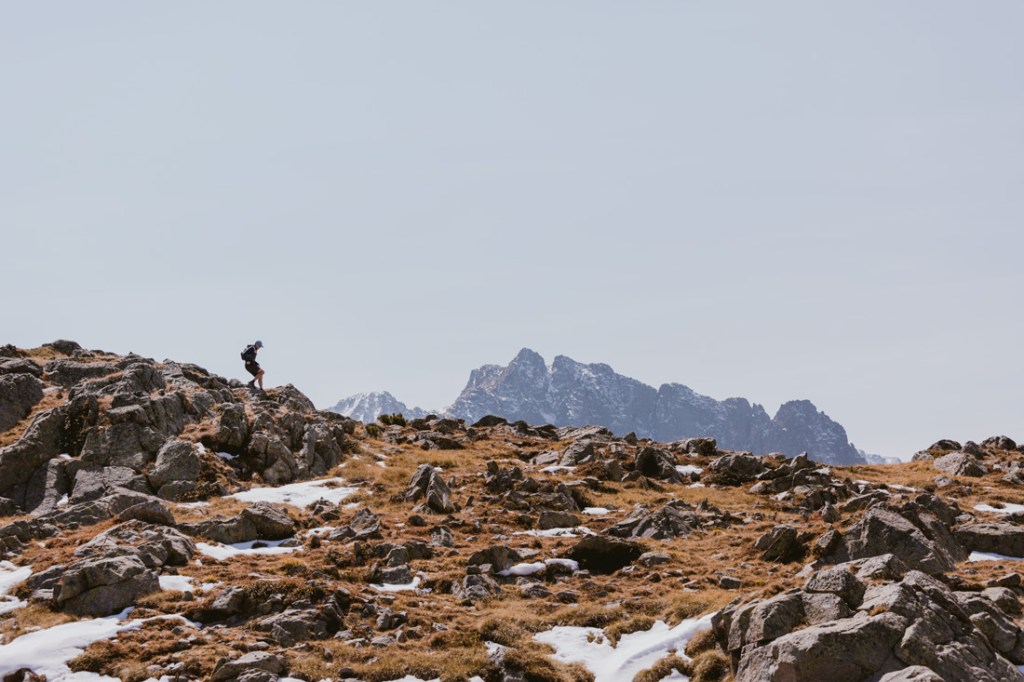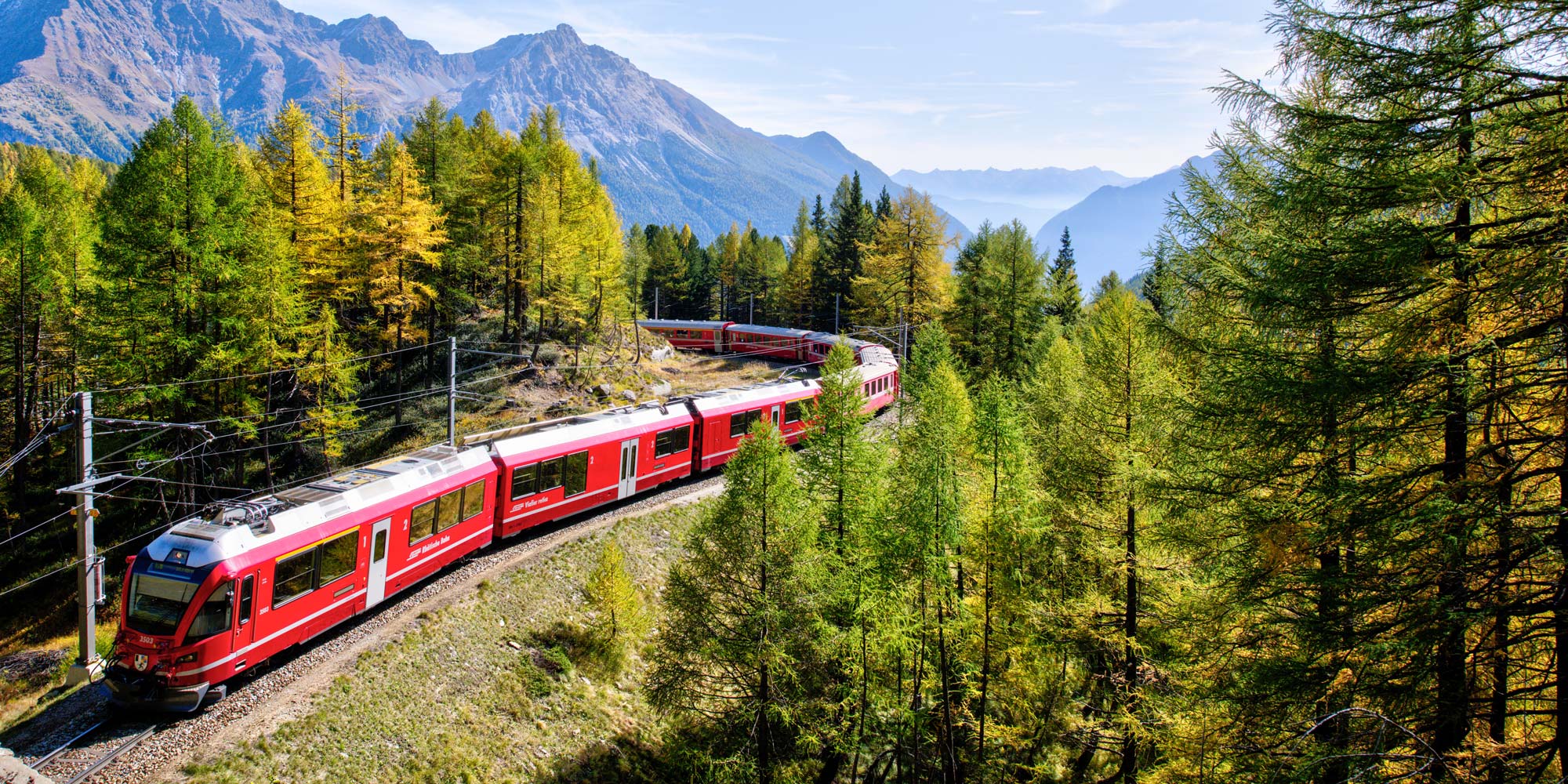Traveling Europe by train is an adventure in itself, but railways are the very definition of “the beaten path.” However, if you think trains are only good for getting from city to city, think again. With more than 40,000 stops, Europe’s content-spanning rail network can actually be the carless adventurer’s best friend. If you know where to look. Here are eight outdoor destinations that showcase the geographic breadth and sweeping range of activities—from climbing and biking to paddling and hiking—that are just a train ride away.
Hike Mont Blanc
France, Italy and Switzerland

Hikers circumnavigate Mont Blanc.
Imagine strolling into the heart of Montana’s Glacier National Park straight out of a train car and you’ll have a sense of the absurd ease with which you can explore Mont Blanc in the French Alps. From Chamonix’s Chamonix-Mont Blanc station, you’re just a 10-minute walk and two gondola rides away from Le Brévent, an 8,300-foot mountain and the start of the iconic Tour du Mont Blanc, one of Europe’s best-known thru-hikes. It’ll take a week or two and 106 miles to circumnavigate the entire 15,781-foot massif, but the region’s famed huts dot the trail, so you don’t have to rough it. Plus, you’ll pass dozens of towns and villages along the way, meaning you’ll have no problem bussing back to Chamonix if you cut the route short. Don’t sweat it if you didn’t pack your hiking kit. You can rent one from Décathlon City, an outfitter just a three-minute walk from the station.
Explore the Curonian Spit
Klaipeda, Lithuania
The Curonian Spit, a 61-mile strip of wooded sand dunes, shelters southern Lithuania from the Baltic Sea near Klaipeda, the country’s largest coastal town. Legend has it that a local girl bloomed into a giant goddess and built the sand spit to protect fishermen from fierce sea winds. Today, her handiwork protects a national park and UNESCO Heritage site teeming with herons and cormorants, idyllic lagoons, white-sand beaches and traditional fishing villages. A bike path runs the Lithuanian side of the Spit to the town of Nida, or better yet, book a kayaking tour in Klaipeda and take in the dunes from the water. Best part? As of 2020, the Baltic is on the Eurail Pass, an all-inclusive system that allows you to travel to 33 European countries with a single ticket.
Bag Ben Nevis
Fort William, Scotland

The Scottish Highlands near Ben Nevis. (Photo Credit: Scottishstoater)
Though it tops out at just 4,413 feet, Ben Nevis—whose name translates as “mountain with its head in the clouds”—clocks in as the United Kingdom’s tallest mountain. The remains of an ancient volcano, it is also a peakbagging icon and an epic day hike. Take the train from Glasgow to Fort William, which passes through Loch Lomond & The Trossachs National Park, and from the town center, it’s a quick, 2-mile taxi ride to the trailhead at the Ben Nevis Visitor Center. Or hoof it. You’re hiking anyway. From the visitor center, take the Mountain Track, a steep-and-stony 10.5-mile out-and-back through native trees, lichens and wood anemones up to the scree-strewn summit. Keep an eye out for golden eagles, pine martens, wildcats and wizards. (There are several filming locations from Harry Potter films nearby, including the Steall Waterfall and the red Jacobite steam train which crosses the famed Glenfinnan Viaduct near Fort William.)
Mountain Bike The Swiss Epic
Laax, Switzerland
The Swiss Epic is a two-person mountain bike stage race that traverses the rugged Alpine ridges of eastern Switzerland’s Graubünden region. This year’s route (August 18-22) winds 217 miles between the towns of Laax and Davos, gaining some 39,000 feet of elevation along the way. But you don’t need a race bib to enjoy the ride. From the train station in Chur, Switzerland, it’s a 40-minute bus ride to Laax, which alone boasts more than 200 miles of marked routes. Rent your ride and gear in town at any of half a dozen spots, then hit trails like the 21-mile Sengas Tour, which circumnavigates Flimserstein mountain, and The Never End Trail, 7 miles of challenging freeride singletrack. Or, if you’ve got the legs, tackle the entire Swiss Epic route at your own pace. Bike hotels, ride-in mountain restaurants, lifts and cable cars will help you along this Alpine singletrack paradise.
Surf La Zurriola Beach
San Sebastián, Spain
San Sebastián is widely hailed as one of Europe’s best surf towns. Step off at Donostia-San Sebastián station (a direct shot from Madrid, Pamplona or Barcelona and an easy transfer from Bordeaux, France), and it’s a 15-minute walk straight to La Zurriola Beach, home to the city’s best waves. Grab a rental board on the way at Pukas Surf Eskola or Surfing San Sebastián (both of which offer lessons), and paddle out to the sandy-bottomed right- and left-hand beach breaks. Find the best waves October through December, or come in May, June and September for warmer water, thinner crowds and more beginner-friendly surf. Still feeling adventurous when the waves are slow? The full northern route of the famous Camino de Santiago starts in town.
Camp in the Pyrenees
Lourdes, France

A hiker a Pyrenees and Costa Brava guided hiking trip.
The Pyrenees are crammed with rugged mountains, hot springs, alpine lakes and ancient cultural sites. They’re also surprisingly accessible, so why not set up camp for awhile and explore? From the Lourdes train station on the French side of the border, it’s just a $2, 45-minute ride on the 965 bus to Saligos-Passerelle, where you’ll have a few camping options in the immediate vicinity. Camping Pyrenevasion, Camping International and Camping Airotel Pyrenees each have dozens of sites, mountain views and shuttle access to three ski areas with expansive options for hiking, biking, rafting, canyoneering and hot-tub soaking. Or head to Pyrenees National Park, another UNESCO Heritage site that protects the region’s biodiversity and cultural significance—humans have inhabited the region since 40,000 BC, and the park protects the last remaining vestige of a pastoral way of life that was once-widespread in Europe’s upland regions.
Rock Climb Ojców National Park
Krakow, Poland
Sport climbing in Poland’s Jura Upland, a stony highland just north of Krakow, has long been a well-kept (and well-loved) secret, but the sport was prohibited in the region’s cliff-riddled Ojców National Park. Then in 2015, a single overhanging crag called Pochylec finally opened to the public, and today the park has nearly two dozen bolted routes and tests some of the country’s top climbers. A $20 taxi will get you from Krakow Glowny, the city’s main railway station, to the park’s northern entrance, and from there it’s a 10-minute walk to the 13-route Pochylec crag. When you’ve had your fill of climbing, head deeper into the park to hike through the broadleaf forest and past a medieval castle.
Pedal the Archipelago Trail
Turku, Finland
Off the southwestern coast of Finland lies a scrum of 20,000 scattershot islands called the Turku Archipelago, and this circular, 150-mile hiking and biking route manages to connect a healthy chunk of them. If you don’t have time to hike, rent a pair of wheels in Turku, the 13th-century city that serves as the trail’s start and end point, and explore the route’s rocky islets and quaint fishing villages from the saddle. Ride it in a single go or shorten it into bite-size chunks like the 60-mile Little Archipelago Trail. Whichever option you choose, bed and breakfasts, rental cottages and camping abound, and restaurants are easy to come, meaning it’s easy to travel light. And if you just can’t get enough of the region’s expansive seascapes, catch a ferry on the islands of Nagu or Korpo to reach Archipelago National Park, a UNESCO Biosphere Reserve.
